For effective coastal windbreaks, consider these salt-tolerant champions: Elaeagnus X Ebbingei with its dense silver-green foliage, tall Maritime Pines for severe exposure, thorny Rosa Rugosa, feathery Tamarix that reduces wind by 60%, nitrogen-fixing Sea Buckthorn, versatile Euonymus Japonicus, and silver-leaved Atriplex Halimus. You’ll benefit from their minimal maintenance needs and wildlife-friendly characteristics. Each plant offers unique advantages for protecting your coastal garden from harsh elements.
Elaeagnus X Ebbingei: the Ultimate Coastal Hedge Barrier
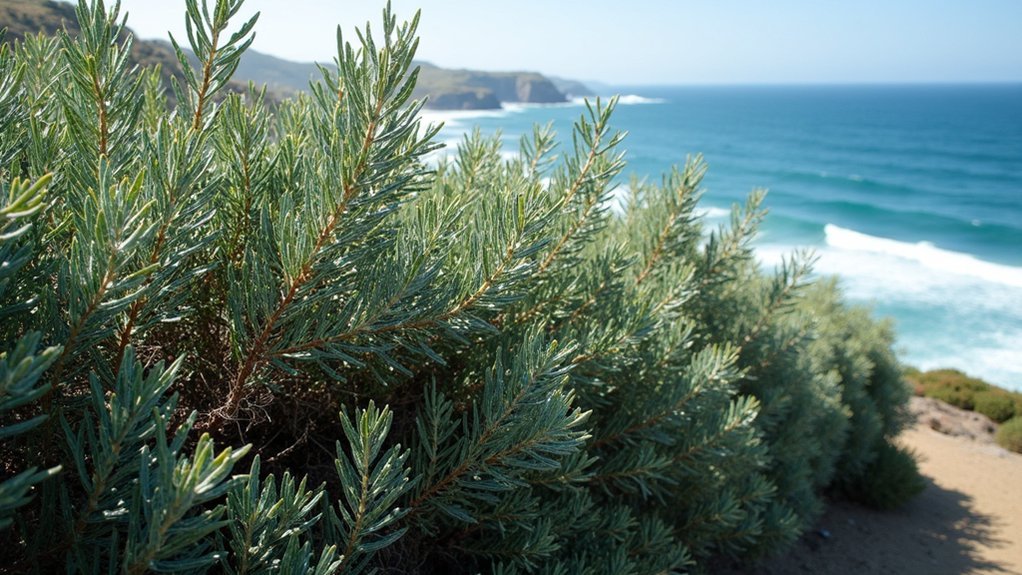
When looking for a resilient windbreak that can withstand harsh coastal conditions, Elaeagnus x ebbingei stands as an exceptional choice. This versatile shrub thrives where other plants struggle, adapting to poor soils while tolerating salt spray and strong prevailing winds.
You’ll appreciate how quickly this plant establishes an effective windbreak, growing to impressive heights of 10-15 feet. Its dense foliage creates a protective microclimate for more delicate plants by considerably reducing wind speed.
The silver-green leaves provide year-round interest, while late fall brings fragrant flowers that attract pollinators.
The silvery foliage delights through all seasons, complemented by autumn’s fragrant blooms that become pollinator havens.
As a coastal windbreak, Ebbinge’s silverberry offers multiple benefits beyond wind protection—including edible berries for wildlife and the ability to form a substantial hedge barrier with minimal maintenance.
Maritime Pines: Tall Windbreaks for Severe Coastal Exposure
Unlike many trees that struggle in harsh shoreline conditions, maritime pines (Pinus pinaster) stand as towering sentinels against the most punishing coastal elements. You’ll find these tall windbreaks growing up to 30 meters high while adding an impressive 1-2 meters annually.
These resilient giants thrive where others fail, developing deep root systems that anchor firmly in sandy, nutrient-poor soils while withstanding salt spray and powerful winds.
| Feature | Benefit | Application |
|---|---|---|
| Fast growth rate | Quick establishment | Rapid protection |
| Dense foliage | Superior wind barrier | Garden shelter |
| Height (25-30m) | Extended protection zone | Large property coverage |
Beyond their practical function as tall windbreaks, maritime pines create valuable wildlife habitat, offering food and shelter through their generous canopy and seed-bearing cones.
Rosa Rugosa: Thorny Protection With Seaside Hardiness
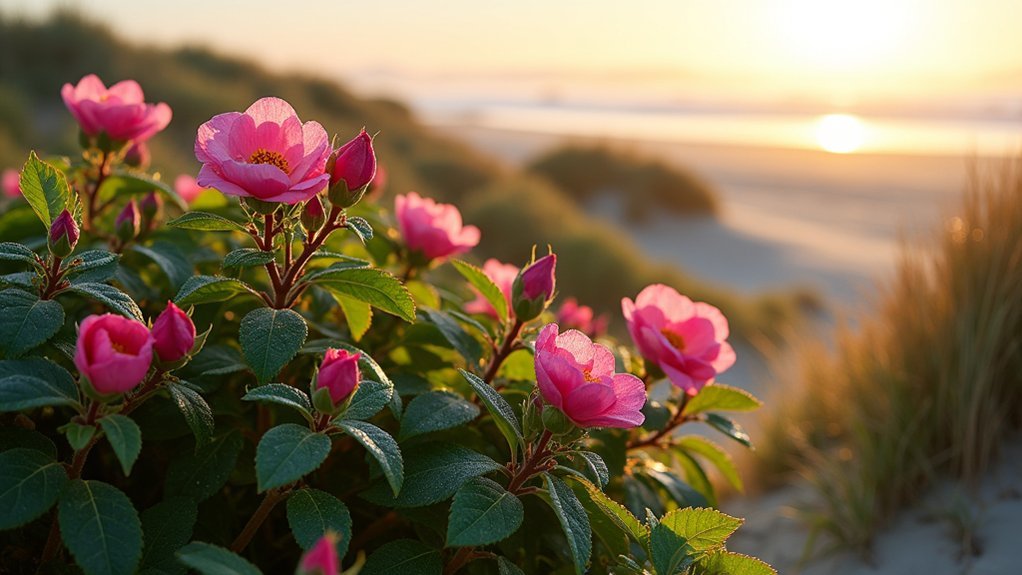
Rosa rugosa’s tough, salt-tolerant nature makes it your go-to choice for beachside protection, surviving where other ornamental shrubs fail.
Its dense, thorny branches create effective wind barriers year-round, with evergreen varieties maintaining protection even through winter months.
You’ll appreciate how this versatile shrub doubles as a wildlife sanctuary, attracting beneficial insects with its fragrant blooms and providing shelter for small birds seeking refuge from coastal gusts.
Salt-Tolerant Beach Rose
Seaside gardeners treasure beach rose (Rosa rugosa) for its remarkable ability to thrive where other plants surrender to coastal challenges. This salt-tolerant beach rose creates effective natural windbreaks while offering multi-season appeal.
You’ll appreciate this hardy shrub’s dense, thorny growth that forms protective barriers against erosion and shields more delicate plantings. It adapts beautifully to poor, sandy soils where few other ornamentals survive.
| Feature | Benefit | Season |
|---|---|---|
| Fragrant blooms | Attracts pollinators | Spring-Fall |
| Decorative rose hips | Wildlife food source | Fall-Winter |
| Thorny branches | Wind & erosion protection | Year-round |
Plant beach roses along your shoreline property to combine practical windbreak functionality with stunning visual appeal—their colorful flowers and attractive hips guarantee your coastal landscape remains both beautiful and resilient.
Year-Round Wind Protection
When winter’s harsh gales sweep across coastal landscapes, Rosa rugosa stands firm, providing unmatched year-round protection for your shoreline garden.
Unlike deciduous windbreak options that lose their effectiveness in colder months, this hardy shrub maintains its dense structure throughout all seasons.
You’ll appreciate how its thorny branches create an effective barrier against strong coastal winds while simultaneously deterring deer and other wildlife from disturbing your garden sanctuary.
The plant’s remarkable adaptability to poor soil conditions means you won’t need to fuss with amendments or special care routines.
Plant several beach rose shrubs in a row to establish a living windbreak that offers privacy, security, and wind protection with minimal maintenance.
Its year-round resilience guarantees your coastal garden remains sheltered regardless of season or weather conditions.
Wildlife-Friendly Barrier
Though formidable with its thorny branches, Rosa rugosa creates a paradoxical sanctuary for coastal wildlife while keeping unwanted visitors at bay.
This resilient shrub stands 3-6 feet tall and spans 4-6 feet wide, forming an effective wildlife-friendly barrier that reduces wind speeds and prevents erosion.
You’ll appreciate how Rosa rugosa thrives in challenging coastal conditions—adapting effortlessly to sandy, saline soils where other plants fail.
Its fragrant, showy blooms attract essential pollinators, enhancing local biodiversity, while the vitamin C-rich rose hips provide nourishment for birds and small mammals.
Tamarix: Feathery Screens for Salt-Laden Winds

Among the most resilient plants for coastal windbreaks, Tamarix stands out with its delicate, feathery foliage that belies its remarkable toughness.
You’ll find this adaptable genus thriving in poor, sandy soils where other plants struggle, making it perfect for challenging coastal environments.
Growing 10-15 feet tall, Tamarix creates effective screens that can reduce wind speed by up to 60%, protecting your garden from salt-laden coastal breezes.
Plant them in clusters or rows for maximum protection.
You’ll enjoy their ornamental value too—small pink or white flowers appear in late spring, attracting pollinators and beneficial insects.
Beyond wind protection, these feathery screens provide habitat for various bird species, adding ecological value to your coastal landscape.
Escallonia: Flowering Windbreaks for Milder Shores
While Tamarix excels in harsh coastal conditions, Escallonia offers a more ornamental alternative for milder shoreline gardens. This hardy shrub combines practicality with beauty, growing 3-5 meters tall with dense, glossy green leaves that effectively block strong winds and salt spray.
You’ll appreciate Escallonia’s fragrant summer blooms that transform your windbreak into a pollinator haven, attracting bees and butterflies to enhance your garden’s biodiversity. The evergreen leaves provide year-round protection while creating an attractive privacy screen.
What makes Escallonia particularly valuable is its adaptability to coastal challenges, thriving even in poor, sandy soils. Regular pruning will maintain its shape and encourage denser growth, improving its windbreak effectiveness while keeping your seaside garden both protected and visually appealing.
Sea Buckthorn: Wildlife-Friendly Storm Barriers
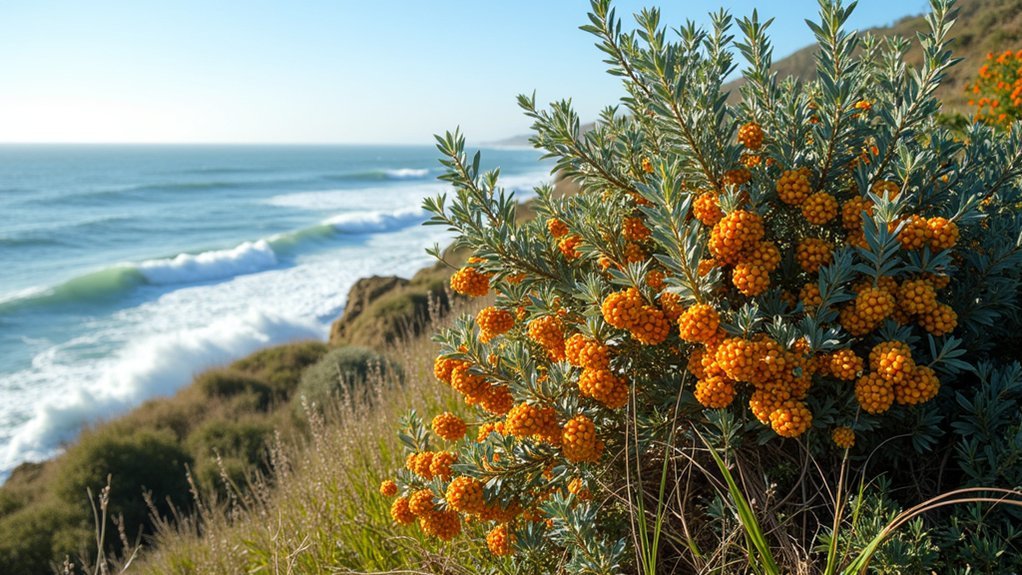
You’ll find Sea Buckthorn’s dense, thorny branches create exceptional windbreaks while its vibrant orange berries attract diverse bird species to your coastal garden.
This hardy shrub shrugs off salt spray and coastal gales, forming protective barriers up to 3 meters tall that shield more delicate plants from harsh maritime conditions.
Beyond wind protection, its nitrogen-fixing capabilities improve your soil quality, creating a wildlife sanctuary that thrives in challenging seaside environments.
Tough Orange Berry Producer
Sea Buckthorn stands as a powerhouse in coastal windbreak plantings, combining rugged durability with ecological benefits.
You’ll find this thorny shrub thriving in the harshest coastal areas, where its salt tolerance and preference for sandy, well-drained soils make it perfectly adapted to seaside conditions.
Growing up to 10 feet tall and 6 feet wide, this robust plant creates an effective barrier against punishing winds while producing vibrant orange berries packed with nutrients.
These vitamin-rich fruits attract diverse wildlife, enhancing your garden’s biodiversity while serving practical purposes.
The dense foliage greatly reduces wind velocity, protecting your more delicate plants and structures from damage.
If you’re looking for a multifunctional windbreak that offers both protection and ecological value, Sea Buckthorn delivers impressive results in challenging maritime environments.
Salt-Spray Defying Hedge
When harsh coastal winds meet the destructive force of salt spray, most plants surrender—but not sea buckthorn. This remarkable shrub thrives where others fail, creating a salt-spray defying hedge that protects your entire garden ecosystem.
You’ll appreciate how sea buckthorn’s thorny, dense growth forms an effective barrier, greatly reducing wind speeds and creating sheltered microclimates for less hardy plants. Its ability to fix nitrogen improves even the poorest soils, benefiting neighboring vegetation without extra fertilizer.
The vibrant orange berries add year-round visual interest while attracting wildlife and pollinators to your coastal garden.
Birds’ Coastal Haven
Birds flock to sea buckthorn windbreaks in droves, creating a thriving coastal haven amid harsh maritime conditions. When you plant this thorny shrub along your coastline, you’re inviting a remarkable diversity of wildlife to your property.
Sea buckthorn’s vibrant orange berries provide essential nutrition for birds throughout fall and winter when other food sources become scarce. Meanwhile, its dense growth creates perfect nesting opportunities and shelter from predators and storms.
Beyond supporting avian populations, your sea buckthorn windbreak serves multiple purposes. Its extensive root system stabilizes sandy soils, preventing erosion during coastal storms.
You’ll appreciate how its silvery-green foliage filters strong winds, creating a protected microclimate for your garden and home while withstanding salt spray that would damage less hardy plants.
Euonymus Japonicus: Versatile Evergreen Windbreak Hedging
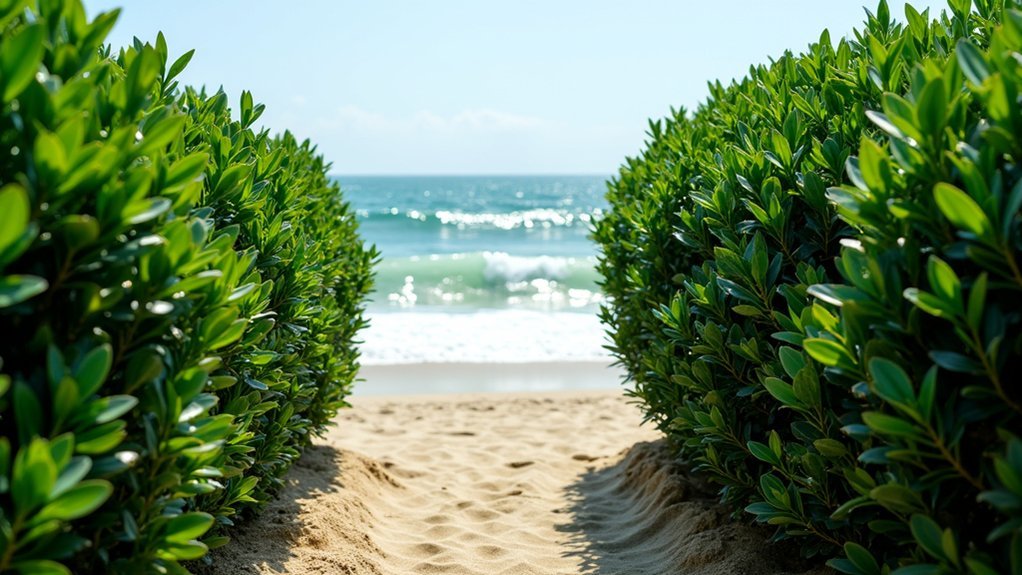
Japanese euonymus stands out as an exceptional choice for coastal windbreaks because of its remarkable adaptability and dense growth habit. This versatile evergreen thrives in various soil conditions while tolerating both dry and coastal environments, making it perfect for oceanside protection.
Japanese euonymus delivers outstanding coastal wind protection through its adaptable nature and thick, resilient foliage structure.
You’ll appreciate the dense foliage that effectively filters wind while providing year-round greenery. Growing to 3-5 feet tall, it creates an ideal low windbreak that won’t overwhelm your landscape but still offers substantial protection.
In late spring, the shrub produces small flowers followed by decorative fruits that attract birds, enhancing your garden’s biodiversity. Regular pruning maintains its compact structure and maximizes its windbreak effectiveness.
For a resilient, attractive coastal barrier that serves multiple functions, you can’t go wrong with Euonymus japonicus.
Olearia: Daisy Bush Barriers for Quick Coastal Protection
If you’re seeking rapid wind protection for your coastal property, Olearia daisy bushes offer one of the most efficient natural barriers available.
These hardy shrubs thrive in sandy, saline conditions where other windbreak trees might struggle, reaching heights of up to 3 meters with dense, protective foliage.
You’ll appreciate how quickly Olearia establishes itself, providing immediate protection for more delicate plants in your coastal garden.
Their impressive resilience against salt spray and fierce marine winds makes them ideal for challenging seaside environments.
Beyond their practical benefits, these daisy bushes enhance your landscape with attractive white or purple flowers that attract pollinators.
Consider planting Olearia axillaris as part of your windbreak strategy for a solution that combines functionality with ornamental appeal.
Griselinia Littoralis: New Zealand’s Answer to Coastal Windbreaks
Coastal gardeners seeking robust windbreak solutions should consider Griselinia littoralis, a versatile evergreen that’s become increasingly popular beyond its native New Zealand shores. This hardy shrub grows 5-8 meters tall and creates an effective barrier against salt spray and fierce winds.
You’ll appreciate Griselinia littoralis for its minimal maintenance requirements and ability to thrive in various soil conditions, even poorly drained coastal areas.
| Feature | Benefit | Application |
|---|---|---|
| Salt tolerance | Survives harsh conditions | Front-line coastal defense |
| Dense foliage | Creates effective windbreak | Privacy screening |
| Wildlife friendly | Supports biodiversity | Ecological landscaping |
Beyond protection, this plant’s glossy green foliage adds aesthetic value while providing habitat for local wildlife, making it an environmentally responsible choice for your coastal landscape.
Atriplex Halimus: Salt-Tolerant Silvery Screens for Harsh Exposures
You’ll find Atriplex halimus’s dramatic silver evergreen foliage creating a stunning visual barrier while effectively blocking harsh coastal winds.
This hardy coastal protection specialist thrives in salt-spray environments where other plants struggle, establishing robust screens up to 3 meters tall in even the poorest soils.
As a low-maintenance drought master, Mediterranean saltbush requires minimal attention once established, freeing you to enjoy its windbreak benefits rather than fussing with complex care routines.
Dramatic Silver Evergreen Foliage
Survivors of the harshest coastal conditions, Atriplex halimus shrubs stand as shimmering sentinels along windswept shores. The dramatic silvery foliage creates a striking visual contrast against coastal landscapes while performing the practical function of deflecting wind and salt spray.
You’ll appreciate how this evergreen retains its metallic sheen year-round, ensuring continuous protection and aesthetic appeal.
When establishing your coastal windbreak, consider these visual qualities:
- Billowing silver-white leaves that catch sunlight like rippling water
- Dense branching pattern creating a textural tapestry that diffuses strong winds
- Height variation of 2-3 meters that provides multi-level screening without blocking ocean views
This resilient plant transforms challenging coastal exposures into elegant, functional landscapes while supporting local wildlife.
Hardy Coastal Protection Specialist
In the harshest coastal environments, Atriplex halimus emerges as nature’s perfect windbreak solution. This Mediterranean saltbush stands resilient at 1-2 meters tall, creating effective barriers against punishing sea winds while stabilizing sandy soils beneath.
You’ll appreciate its silvery, succulent foliage that not only withstands extreme coastal situations but actually improves surrounding soil through nitrogen fixation. Plant this specialist where other shrubs struggle, and you’ll create protective zones for more delicate garden specimens.
Beyond its practical benefits, this hardy shrub doubles as valuable wildlife habitat, attracting pollinators and providing shelter for birds.
When you need a low-maintenance screen that thrives in salt-laden air and poor soils, Atriplex halimus delivers exceptional performance while enhancing your coastal ecosystem’s biodiversity.
Low-Maintenance Drought Master
Low-Maintenance Drought Master
Atriplex Halimus: Salt-Tolerant Silvery Screens for Harsh Exposures
Gardeners treasure Atriplex halimus for its remarkable drought tolerance that eliminates the need for constant maintenance in coastal landscapes.
This Mediterranean saltbush thrives where other plants struggle, creating dense silvery-green screens that filter harsh winds while requiring minimal care once established.
As a true drought master, you’ll appreciate these benefits:
- Zero fussing required – Plant it in saline soils and forget it; this shrub needs little water after establishment.
- Natural coastal barrier – Grows to 1.5 meters tall, creating effective windbreaks that protect your garden.
- Wildlife sanctuary – Provides shelter for local fauna while controlling erosion on challenging coastal sites.
You’ll find few low-maintenance options that perform so admirably in harsh, salt-sprayed environments.
Frequently Asked Questions
What Is the Best Natural Windbreak?
Your best natural windbreak combines mixed evergreens and shrubs like Cupressus leylandii and Banksia integrifolia. They’ll reduce wind speed by 50-60% and protect areas up to ten times their height when properly spaced.
What Is the Best Coastal Evergreen?
For the best coastal evergreen, you’ll want Cupressus leylandii. It grows up to 1 meter yearly with dense foliage for excellent wind protection. Banksia integrifolia and Waterhousia floribunda are also outstanding salt-tolerant options.
What Is the Fastest Growing Windbreak?
You’ll find Thuja ‘Green Giant’ is the fastest growing windbreak, adding 3-5 feet annually and reaching 30-40 feet at maturity. Leyland cypress and Cupressus leylandii are also impressive, growing about 3 feet yearly.
What Plants Are Good for Blocking Wind?
You’ll find Cupressus leylandii and Waterhousia floribunda excellent for blocking wind. Don’t overlook Elaeagnus x ebbingei for its dense growth or Hippophae rhamnoides which offers thorny protection while producing edible berries as a bonus.
In Summary
You’ve now discovered ten exceptional plants that’ll transform your coastal garden into a sheltered haven. Whether you’re battling fierce ocean winds or salt spray, these natural windbreaks offer protection while enhancing your landscape’s beauty. From the robust Elaeagnus to the silvery Atriplex, you’ll find options for any coastal condition. Choose plants suited to your specific shoreline environment, and you’ll soon enjoy a more peaceful, protected outdoor space.

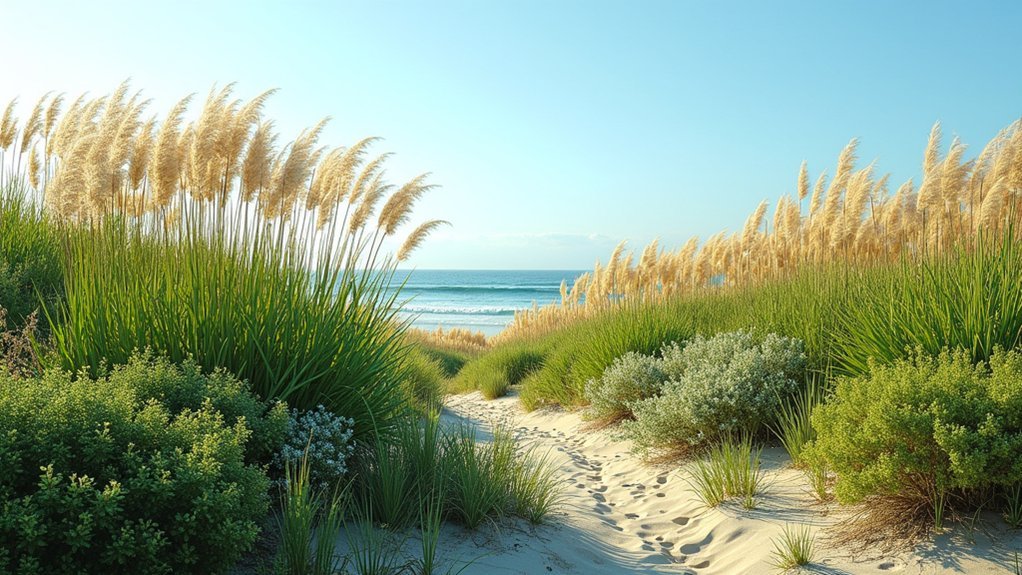



Leave a Reply